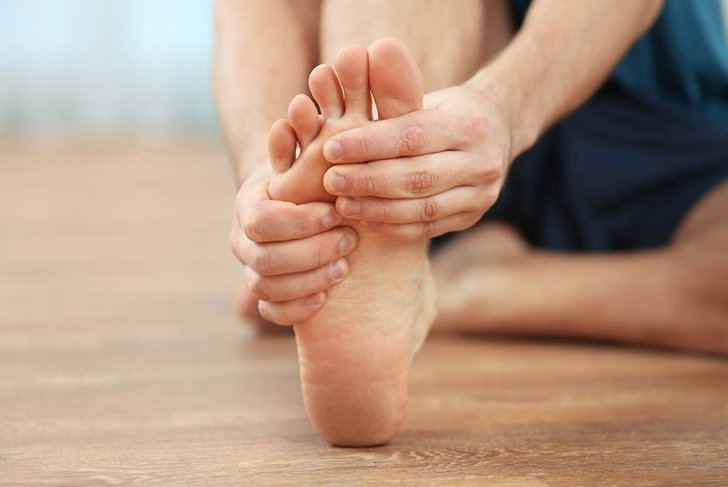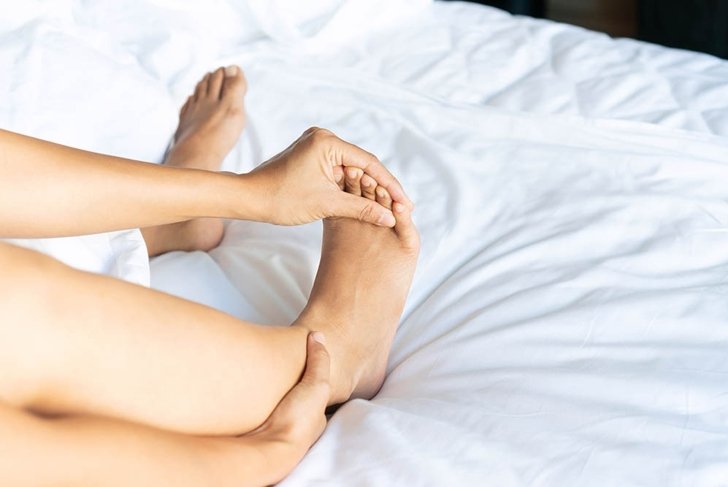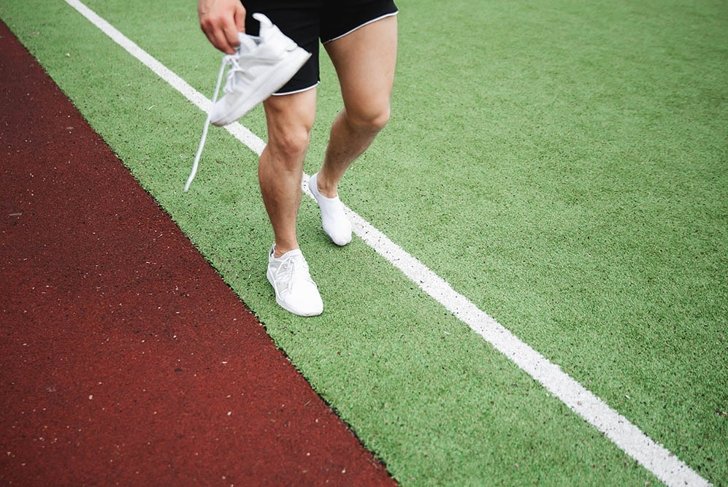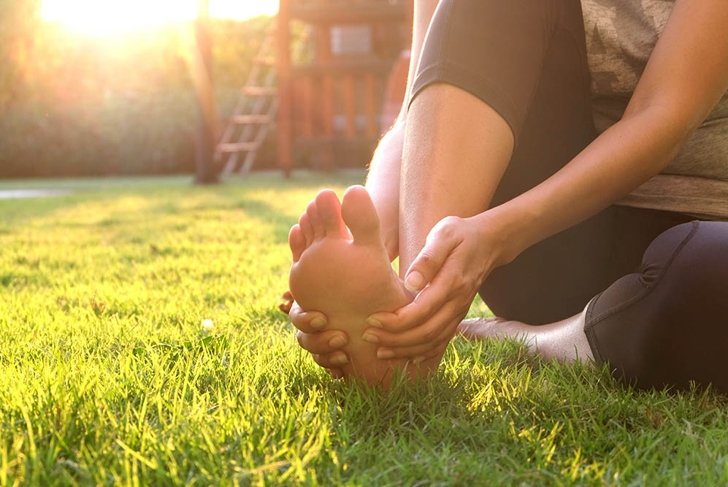
Has heel pain got you down? Explore all things plantar fasciitis in this deep dive, including home remedies that are truly effective. You might just find yourself fascia-nated.

01
Problems afoot
Plantar fasciitis is simply explained as inflammation of the plantar fascia ligament. This ligament connects the heel to the front of the foot, supporting the arch. It lies under the skin on the bottom of the foot.
Heel pain is a real, well, pain. It mostly affects athletes and those who stand for long amounts of time (particularly on hard surfaces) and can cause immense discomfort. It’s estimated that one in 10 people will experience plantar fasciitis in their lifetimes, so it’s a fairly common issue.
Discover the causes and symptoms of plantar fasciitis, and how to prevent and treat it, should it affect you.
02
Causes
 When repeated stretching and tearing of the plantar fascia occur, the ligament becomes inflamed and irritated. This ligament is rubber band-like and shaped like a bowstring. It absorbs shock and supports the arch of the foot. It can become easily weakened and irritated when too much tension or stress occurs, which causes small tears.
When repeated stretching and tearing of the plantar fascia occur, the ligament becomes inflamed and irritated. This ligament is rubber band-like and shaped like a bowstring. It absorbs shock and supports the arch of the foot. It can become easily weakened and irritated when too much tension or stress occurs, which causes small tears.
The main causes of plantar fasciitis are
- repeated running or jumping (which is why it’s particularly common among athletes)
- standing or exercising on hard surfaces
- walking or running barefoot
- exercising without stretching your calves
- wearing unsupportive shoes
- maintaining an unhealthy weight (up to 70 percent of those affected are obese)
Another cause is flatfoot, which simply shows how crucial the foot arch is in supporting and absorbing body weight, particularly during weight-bearing activities or sports.
03
Symptoms
 Those who suffer from plantar fasciitis typically have pain immediately upon waking up in the morning. Here are the most common symptoms:
Those who suffer from plantar fasciitis typically have pain immediately upon waking up in the morning. Here are the most common symptoms:
- pain near the heel of the foot
- pain when you take your first steps of the day
- pain after long periods of rest (for example, sitting in the car for a long time and then standing up to walk). The pain typically subsides after a few minutes
- pain after exercising or increased activity (not during)
Be sure to look out for these symptoms and seek help if you need it.
04
Risk factors
 Plantar fasciitis can develop without any obvious symptoms, but there are risk factors that can contribute to your chances of getting it. They include:
Plantar fasciitis can develop without any obvious symptoms, but there are risk factors that can contribute to your chances of getting it. They include:
- athleticism—more common in runners, ballet dancers, aerobic dancers, soccer players
- BMI or weight—more common in those who are obese
- age—common among those between the ages of 40 and 60 (particularly females of that age group)
05
When should you see a doctor?
 You may be asking yourself, “When should I see a doctor about my heel pain?” and you’re not alone. Plantar fasciitis results in more than 1 million visits to foot physicians and primary care physicians every year.
You may be asking yourself, “When should I see a doctor about my heel pain?” and you’re not alone. Plantar fasciitis results in more than 1 million visits to foot physicians and primary care physicians every year.
Occasional pain is not alarming, but ongoing pain is worthy of a doctor’s visit. Especially if it doesn’t improve over time, or is, in fact, getting worse, please consult a health care practitioner.
06
Diagnosis
 Your doctor will perform a physical examination and take your medical history into account when diagnosing plantar fasciitis. If necessary, further testing may be required or requested.
Your doctor will perform a physical examination and take your medical history into account when diagnosing plantar fasciitis. If necessary, further testing may be required or requested.
- X-ray—gives a clear picture of the foot bones, ruling out arthritis or fractures.
- MRI scan—may be ordered if initial treatments are not healing the foot pain.
- ultrasound—shows increased thickness of the plantar fascia and any abnormal tissue.
Note that diagnostic testing is typically not needed for an initial diagnosis.
07
Home remedies
 Plantar fasciitis may be improved with simple at-home remedies. In fact, more than 90 percent of patients will see improvement within 10 months of trying these DIY treatments:
Plantar fasciitis may be improved with simple at-home remedies. In fact, more than 90 percent of patients will see improvement within 10 months of trying these DIY treatments:
- ice—three to four times a day, 20 minutes at a time
- rest—you may need to stop aggressive fitness activity
- stretch—calf stretches, plantar fasciitis stretch, towel stretches
- wear—avoid unsupportive footwear
- massage—focus on the heel and arch of the foot
08
Physician-directed remedies
 If necessary, you may need to see a doctor for your plantar fasciitis. The following may be considered:
If necessary, you may need to see a doctor for your plantar fasciitis. The following may be considered:
- cortisone injections
- prescribed supportive shoes
- physical therapy
- night splints
In extreme cases, surgery may be required:
- plantar fascia release surgery—the plantar fascia is partially cut to relieve some of the tension.
- gastrocnemius recession—this surgery lengthens the calf muscles (tight calf muscles add stress to the plantar fascia).
This affliction inconveniences nearly 2 million people in the US every year, so it’s important to take the appropriate steps, as needed, to heal (heel?) your pain.
09
Recovery
 It may take months to recover from plantar fasciitis, or get rid of symptoms all together with home remedies. If your doctor doesn’t see any improvement with aggressive nonsurgical treatment after 12 months, surgery may be considered. It can take up to 10 weeks to recover from surgery.
It may take months to recover from plantar fasciitis, or get rid of symptoms all together with home remedies. If your doctor doesn’t see any improvement with aggressive nonsurgical treatment after 12 months, surgery may be considered. It can take up to 10 weeks to recover from surgery.
When both home remedies and surgery have been involved, it may take over a year to recover.
10
Complications
 Those affected by plantar fasciitis may alter the way they walk as a means to relieve their heel pain, which can lead to other complications. They may shift their posture to put less weight on their foot, affecting different muscles in their bodies. Prolonged foot pain can introduce ankle, knee, hip, leg, or back problems and particularly affects those with diabetes.
Those affected by plantar fasciitis may alter the way they walk as a means to relieve their heel pain, which can lead to other complications. They may shift their posture to put less weight on their foot, affecting different muscles in their bodies. Prolonged foot pain can introduce ankle, knee, hip, leg, or back problems and particularly affects those with diabetes.
11
Prevention tips
 Let’s get right down to it: prevention is key to ensuring you never get plantar fasciitis or at least ensuring you don’t get it again. With simple exercises and strategy, you can protect your feet and safeguard your health for pain-free living.
Let’s get right down to it: prevention is key to ensuring you never get plantar fasciitis or at least ensuring you don’t get it again. With simple exercises and strategy, you can protect your feet and safeguard your health for pain-free living.
Here are some general heel pain prevention tips:
- stretch daily
- tape your arches
- rest your feet
- apply ice, as needed
- perform low-impact exercises that don’t put pressure on your feet (swimming is particularly good!)
- massage
- maintain a healthy weight
- wear supportive shoes (see an orthopedic doctor for customized orthotics)
- avoid going barefoot, especially on hard surfaces
Just make sure you’re consistent (or, you know, put your best foot forward).



